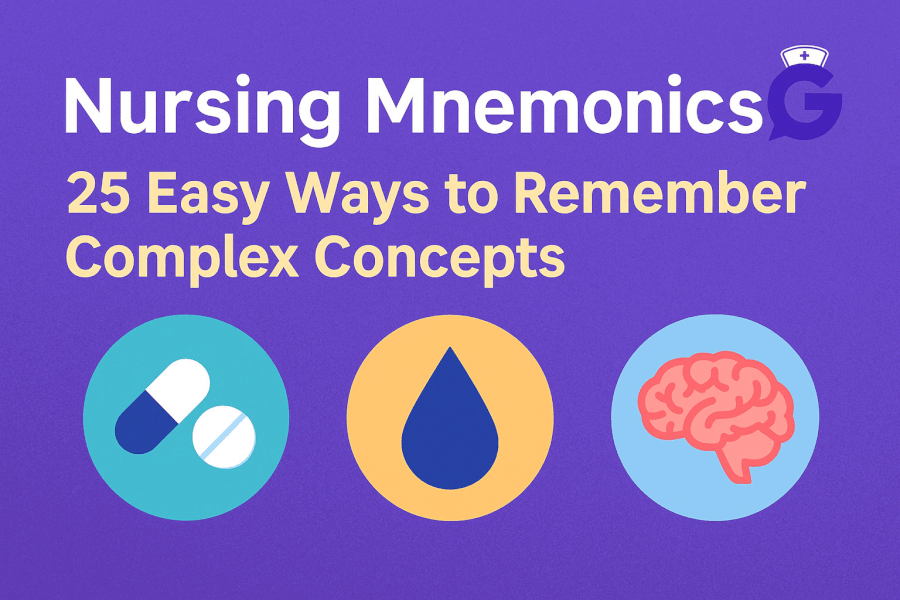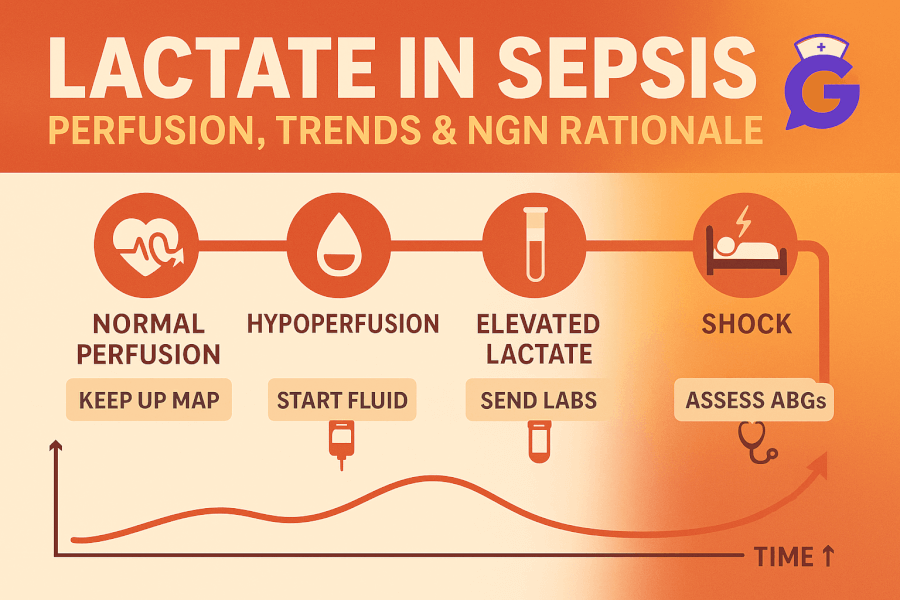Let’s face it - nursing school is hard. Between complex pharmacology, endless lab values, and care plans that feel like puzzles, it’s no wonder so many students rely on mnemonics to help remember what actually sticks.
In this guide, we’re breaking down 25 nursing mnemonics that are easy to remember, clinically relevant, and designed to help you pass the NCLEX and thrive in nursing school.
We'll cover:
- Pharmacology mnemonics > Pharmacology giving you trouble? Our drug class mnemonics article provides more memory tricks for medications.
- Fluid & electrolyte mnemonics
- Psych, OB, and med-surg memory tricks
- Smart acronyms for documentation and prioritization
And wherever relevant, we’ll link you to deeper articles you can use to master these concepts.
Why Use Mnemonics in Nursing School?
Because they work. Mnemonics make it easier to store and retrieve information when it matters most—whether you’re taking the NCLEX, doing clinicals, or charting during a 12-hour shift.
Plus, they’re quick, visual, and fun.
💡 Bonus: GoodNurse has a full breakdown on Pharmacology Mnemonics and Fluid & Electrolyte Mnemonics if you want to go deeper.
🧠 25 Nursing Mnemonics You’ll Actually Remember
1. MONA – Treatment for Myocardial Infarction
Morphine, Oxygen, Nitroglycerin, Aspirin
Used in early MI management to relieve pain, dilate vessels, and reduce platelet aggregation.
2. RICE – Injury Management
Rest, Ice, Compression, Elevation
First-line for sprains, strains, and soft tissue injury.
3. ABCDE – Emergency Assessment Priorities
Airway, Breathing, Circulation, Disability, Exposure
Follow this order in trauma or emergency patient evaluations.
4. SOAP – Documentation Format
Subjective, Objective, Assessment, Plan
Standard format for writing nursing and provider notes.
5. REEDA – Episiotomy Healing
Redness, Edema, Ecchymosis, Discharge, Approximation
Used in postpartum assessments.
6. APGAR – Newborn Assessment
Appearance, Pulse, Grimace, Activity, Respiration
Scored 1 minute and 5 minutes after birth.
7. MATER – Fetal Heart Tracing
Movement, Acceleration, Tone, Excitability, Reactivity
Alternative to BPP components; assess fetal well-being.
8. VEAL CHOP – Fetal Monitoring Interpretation
Variables = Cord compression
Early decels = Head compression
Accelerations = Okay
Late decels = Placental insufficiency
9. TACO – Amniotic Fluid Assessment
Time, Amount, Color, Odor
Use when assessing or documenting ruptured membranes.
10. BRAT – Diet for GI Distress
Bananas, Rice, Applesauce, Toast
Gentle foods after nausea, vomiting, or diarrhea.
💊 Pharmacology Mnemonics
11. SLUDGE – Cholinergic Effects
Salivation, Lacrimation, Urination, Diaphoresis, GI upset, Emesis
Seen in cholinergic overdose or organophosphate poisoning.
12. ANTICHOLINERGIC = Can’t Pee, See, Spit, or Poop
Describes side effects: dry mouth, constipation, blurred vision, urinary retention.
13. NAMES OF INSULINS – L.A.N.D.
Lantus = Long-acting
Apidra = Rapid-acting
Novolog = Rapid-acting
Detemir = Long-acting
For more, check out: Nursing Pharmacology Mnemonics
💧 Fluid & Electrolyte Mnemonics
14. SALT LOSS – Symptoms of Hyponatremia
Seizures, Abd cramps, Lethargy, Tendon reflexes ↓
Loss of urine, Orthostatic hypotension, Shallow respirations, Spasms
15. FRIED SALT – Hypernatremia Signs
Flushed skin, Restlessness, Increased BP, Edema, Decreased urine
Skin dry, Agitated, Low-grade fever, Thirst
16. MURDER – Hyperkalemia Effects
Muscle cramps, Urine abnormalities, Resp distress, Decreased cardiac contractility, EKG changes, Reflexes ↓
For more tricks like these, explore: Fluid & Electrolyte Mnemonics
🧘 Psych & Mental Health Mnemonics
17. SIG E CAPS – Depression Criteria (DSM-5)
Sleep, Interest ↓, Guilt, Energy ↓, Concentration ↓, Appetite, Psychomotor ↓, Suicidal ideation
18. SAD PERSONS – Suicide Risk Factors
Sex (male), Age, Depression, Prior attempt, Ethanol use, Rational thinking loss, Support system loss, Organized plan, No spouse, Sickness
19. BATHE – Therapeutic Communication
Background, Affect, Trouble, Handling, Empathy
🏥 Med-Surg & Priority Mnemonics
20. ARBS – Contraindicated in Pregnancy
Angiotensin Receptor BlockerS (e.g., Losartan)
21. DABDA – Stages of Grief (Kubler-Ross)
Denial, Anger, Bargaining, Depression, Acceptance
22. PAIN – Acute Pain Assessment
Provocation, Associated symptoms, Intensity, Nature
23. PRIORITY = ABCs First
Always think Airway → Breathing → Circulation
24. RN vs. LPN Tasks – Remember “Unstable”
Unstable or acute patients should not be delegated to LPNs.
For more on delegation, check our Ultimate NCLEX Vocabulary Guide
25. I’M CLEAR – SBAR Communication
Introduction, Mechanism/history, Condition, Lab values/vitals, Evaluation, Actions, Recommendation
📌 Final Study Tips
- Don’t memorize blindly — understand the “why” behind each mnemonic.
- Group them by topic (e.g., meds, fluids, OB) and review one section per day.
- Use visuals or printables — draw charts or flashcards.
- Teach a classmate — what sticks is what you explain.
More from GoodNurse:
- 50 Must-Know Nursing Terms for the NCLEX
- Pharmacology Mnemonics
- Fluid & Electrolyte Mnemonics
- NCLEX Prefixes & Vocabulary
- Ultimate NCLEX Vocabulary Guide (2025)
Want a printable PDF of these mnemonics? Visit goodnurse.com to download study tools, guides, and more NCLEX-prep resources.
You’ve got this!







